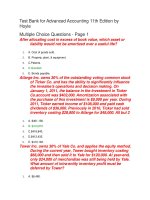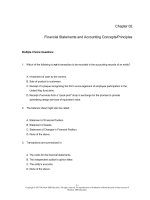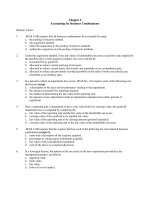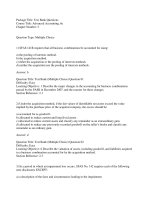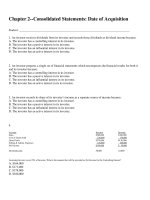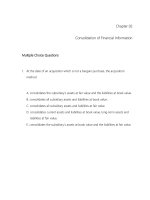Advanced accounting 11th edition fischer test bank
Bạn đang xem bản rút gọn của tài liệu. Xem và tải ngay bản đầy đủ của tài liệu tại đây (460.53 KB, 75 trang )
Chapter 2--Consolidated Statements: Date of Acquisition
Student: ___________________________________________________________________________
1. An investor receives dividends from its investee and records those dividends as dividend income because:
A. The investor has a controlling interest in its investee.
B. The investor has a passive interest in its investee.
C. The investor has an influential interest in its investee.
D. The investor has an active interest in its investee.
2. An investor prepares a single set of financial statements which encompasses the financial results for both it
and its investee because:
A. The investor has a controlling interest in its investee.
B. The investor has a passive interest in its investee.
C. The investor has an influential interest in its investee.
D. The investor has an active interest in its its investee.
3. An investor records its share of its investee’s income as a separate source of income because:
A. The investor has a controlling interest in its investee.
B. The investor has a passive interest in its investee.
C. The investor has an influential interest in its investee.
D. The investor has an active interest in its investee.
4.
Account
Sales
Cost of Goods Sold
Gross Profit
Selling & Admin. Expenses
Net Income
Investor
$500,000
230,000
$270,000
120,000
$150,000
Investee
$300,000
170,000
$130,000
100,000
$ 30,000
Dividends paid
50,000
10,000
Assuming Investor owns 70% of Investee. What is the amount that will be recorded as Net Income for the Controlling Interest?
A. $164,000
B. $171,000
C. $178,000
D. $180,000
5. Consolidated financial statements are designed to provide:
A. informative information to all shareholders.
B. the results of operations, cash flow, and the balance sheet in an understandable and informative manner for
creditors.
C. the results of operations, cash flow, and the balance sheet as if the parent and subsidiary were a single entity.
D. subsidiary information for the subsidiary shareholders.
6. Which of the following statements about consolidation is not true?
A. Consolidation is not required when control is temporary.
B. Consolidation may be appropriate in some circumstances when an investor owns less than 51% of the voting
common stock.
C. Consolidation is not required when a subsidiary’s operations are not homogeneous with those of its parent.
D. Unprofitable subsidiaries may not be obvious when combined with other entities in consolidation.
7. Consolidated financial statements are appropriate even without a majority ownership if which of the
following exists:
A. the subsidiary has the right to appoint members of the parent company's board of directors.
B. the parent company has the right to appoint a majority of the members of the subsidiary’s board of directors
because other ownership interests are widely dispersed.
C. the subsidiary owns a large minority voting interest in the parent company.
D. the parent company has an ability to assume the role of general partner in a limited partnership with the
approval of the subsidiary's board of directors.
8. Consolidation might not be appropriate even when the majority owner has control if:
A. The subsidiary is in bankruptcy.
B. A manufacturing-based parent has a subsidiary involved in banking activities.
C. The subsidiary is located in a foreign country.
D. The subsidiary has a different fiscal-year end than the parent.
9. Which of the following is true of the consolidation process?
A. Even though the initial accounting for asset acquisitions and 100% stock acquisitions differs, the
consolidation process should result in the same balance sheet.
B. Account balances are combined when recording a stock acquisition so the consolidation is automatic.
C. The assets of the noncontrolling interest will be predominately displayed on the consolidated balance sheet.
D. The investment in subsidiary account will be displayed on the consolidated balance sheet.
10. In an asset acquisition:
A. A consolidation must be prepared whenever financial statements are issued.
B. The acquiring company deals only with existing shareholders, not the company itself.
C. The assets and liabilities are recorded by the acquiring company at their book values.
D. Statements for the single combined entity are produced automatically and no consolidation process is
needed.
11. Which of the following is not true of the consolidation process for a stock acquisition?
A. Journal entries for the elimination process are made to the parent’s or subsidiary’s books.
B. The investment account balance on the parent’s books will be eliminated.
C. The balance sheets of two companies are combined into a single balance sheet.
D. The shareholder equity accounts of the subsidiary are eliminated.
12. A subsidiary was acquired for cash in a business combination on December 31, 20X1. The purchase price
exceeded the fair value of identifiable net assets. The acquired company owned equipment with a fair value in
excess of the book value as of the date of the combination. A consolidated balance sheet prepared on December
31, 20X1, would
A. report the excess of the fair value over the book value of the equipment as part of goodwill.
B. report the excess of the fair value over the book value of the equipment as part of the plant and equipment
account.
C. reduce retained earnings for the excess of the fair value of the equipment over its book value.
D. make no adjustment for the excess of the fair value of the equipment over book value. Instead, it is an
adjustment to expense over the life of the equipment.
13. Parr Company purchased 100% of the voting common stock of Super Company for $2,000,000. There are
no liabilities. The following book and fair values pertaining to Super Company are available:
Current assets
Land and building
Machinery
Goodwill
The amount of machinery that will be included in on the consolidated balance sheet is:
A. $560,000
B. $860,000
C. $600,000
D. $900,000
Book Value
$300,000
600,000
500,000
100,000
Fair Value
$600,000
900,000
600,000
?
14. Pagach Company purchased 100% of the voting common stock of Rage Company for $1,800,000. The
following book and fair values are available:
Current assets
Land and building
Machinery
Bonds payable
Goodwill
Book Value
$150,000
280,000
400,000
(300,000)
150,000
Fair Value
$300,000
280,000
700,000
(250,000)
?
The bonds payable will appear on the consolidated balance sheet
A. at $300,000 (with no premium or discount shown).
B. at $300,000 less a discount of $50,000.
C. at $0; assets are recorded net of liabilities.
D. at an amount less than $250,000 since it is a bargain purchase.
15. Which of the following is not an advantage of the parent issuing shares of stock in exchange for the
subsidiary common shares being acquired?
A. It is not necessary to determine the fair values of the subsidiary’s net assets.
B. It may allow the subsidiary’s shareholders to have a tax free exchange.
C. It avoids the depletion of cash.
D. If the parent is publicly held, the share price is readily determinable.
16. When it purchased Sutton, Inc. on January 1, 20X1, Pavin Corporation issued 500,000 shares of its $5 par
voting common stock. On that date the fair value of those shares totaled $4,200,000. Related to the acquisition,
Pavin had payments to the attorneys and accountants of $200,000, and stock issuance fees of $100,000.
Immediately prior to the purchase, the equity sections of the two firms appeared as follows:
Common stock
Paid-in capital in excess of par
Retained earnings
Total
Pavin
$ 4,000,000
7,500,000
5,500,000
$17,000,000
Immediately after the purchase, the consolidated balance sheet should report paid-in capital in excess of par of
A. $8,900,000
B. $9,100,000
C. $9,200,000
D. $9,300,000
Sutton
$ 700,000
900,000
500,000
$2,100,000
17. Pinehollow acquired all of the outstanding stock of Stonebriar by issuing 100,000 shares of its $1 par value
stock. The shares have a fair value of $15 per share. Pinehollow also paid $25,000 in direct acquisition costs.
Prior to the transaction, the companies have the following balance sheets:
Assets
Cash
Accounts receivable
Inventory
Property, plant, and equipment (net)
Total assets
Pinehollow
$ 150,000
500,000
900,000
1,850,000
$3,400,000
Stonebriar
$ 50,000
350,000
600,000
900,000
$1,900,000
Liabilities and Stockholders' Equity
Current liabilities
Bonds payable
Common stock ($1 par)
Paid-in capital in excess of par
Retained earnings
Total liabilities and equity
$ 300,000
1,000,000
300,000
800,000
1,000,000
$3,400,000
$ 100,000
600,000
100,000
900,000
200,000
$1,900,000
The fair values of Stonebriar's inventory and plant, property and equipment are $700,000 and $1,000,000, respectively. The journal entry to record
the purchase of Stonebriar would include a
A. credit to common stock for $1,500,000.
B. credit to paid-in capital in excess of par for $1,100,000.
C. debit to investment for $1,500,000.
D. debit to investment for $1,525,000.
18. When it purchased Sutton, Inc. on January 1, 20X1, Pavin Corporation issued 500,000 shares of its $5 par
voting common stock. On that date the fair value of those shares totaled $4,200,000. Related to the acquisition,
Pavin had payments to the attorneys and accountants of $200,000, and stock issuance fees of $100,000.
Immediately prior to the purchase, the equity sections of the two firms appeared as follows:
Common stock
Paid-in capital in excess of par
Retained earnings
Total
Pavin
$ 4,000,000
7,500,000
5,500,000
$17,000,000
Immediately after the purchase, the consolidated balance sheet should report retained earnings of:
A. $6,000,000
B. $5,800,000
C. $5,500,000
D. $5,300,000
Sutton
$ 700,000
900,000
500,000
$2,100,000
19. Pinehollow acquired all of the outstanding stock of Stonebriar by issuing 100,000 shares of its $1 par value
stock. The shares have a fair value of $15 per share. Pinehollow also paid $25,000 in direct acquisition costs.
Prior to the transaction, the companies have the following balance sheets:
Assets
Cash
Accounts receivable
Inventory
Property, plant, and equipment (net)
Total assets
Pinehollow
$ 150,000
500,000
900,000
1,850,000
$3,400,000
Stonebriar
$ 50,000
350,000
600,000
900,000
$1,900,000
Liabilities and Stockholders' Equity
Current liabilities
Bonds payable
Common stock ($1 par)
Paid-in capital in excess of par
Retained earnings
Total liabilities and equity
$ 300,000
1,000,000
300,000
800,000
1,000,000
$3,400,000
$ 100,000
600,000
100,000
900,000
200,000
$1,900,000
The fair values of Stonebriar's inventory and plant, property and equipment are $700,000 and $1,000,000, respectively. What is the amount of
goodwill that will be included in the consolidated balance sheet immediately following the acquisition?
A. $100,000
B. $125,000
C. $300,000
D. $325,000
20. On April 1, 20X1, Paape Company paid $950,000 for all the issued and outstanding stock of Simon
Corporation. The recorded assets and liabilities of the Simon Corporation on April 1, 20X1, follow:
Cash
Inventory
Property and equipment (net of accumulated depreciation of $320,000)
Liabilities
$ 80,000
240,000
480,000
(180,000)
On April 1, 20X1, it was determined that the inventory of Simon had a fair value of $190,000, and the property and equipment (net) had a fair value
of $560,000. What is the amount of goodwill resulting from the business combination?
A. $0
B. $120,000
C. $300,000
D. $230,000
21. On April 1, 20X1, Paape Company paid $950,000 for all the issued and outstanding stock of Simon
Corporation. The recorded assets and liabilities of the Simon Corporation on April 1, 20X1, follow:
Cash
Inventory
Property and equipment (net of accumulated depreciation of $320,000)
Liabilities
$ 80,000
240,000
480,000
(180,000)
On April 1, 20X1, it was determined that the inventory of Simon had a fair value of $190,000, and the property and equipment (net) had a fair value
of $560,000. The entry to distribute the excess of fair value over book value will include:
A. A debit to inventory of $50,000
B. A credit to the investment in Simon Corporation of $620,000
C. A debit to goodwill of $330,000
D. A credit to the investment in Simon Corporation of $330,000
22. On June 30, 20X1, Naeder Corporation purchased for cash at $10 per share all 100,000 shares of the
outstanding common stock of the Tedd Company. The total fair value of all identifiable net assets of Tedd was
$1,400,000. The only noncurrent asset is property with a fair value of $350,000. The consolidated balance sheet
of Naeder and its wholly owned subsidiary on June 30, 20X1, should report
A. a retained earnings balance that is inclusive of a gain of $400,000.
B. goodwill of $400,000.
C. a retained earnings balance that is inclusive of a gain of $350,000.
D. a gain of $400,000
23. Pinehollow acquired 80% of the outstanding stock of Stonebriar by issuing 80,000 shares of its $1 par value
stock. The shares have a fair value of $15 per share. Pinehollow also paid $25,000 in direct acquisition costs.
Prior to the transaction, the companies have the following balance sheets:
Assets
Cash
Accounts receivable
Inventory
Property, plant, and equipment (net)
Total assets
Pinehollow
$ 150,000
500,000
900,000
1,850,000
$3,400,000
Stonebriar
$ 50,000
350,000
600,000
900,000
$1,900,000
Liabilities and Stockholders' Equity
Current liabilities
Bonds payable
Common stock ($1 par)
Paid-in capital in excess of par
Retained earnings
Total liabilities and equity
$ 300,000
1,000,000
300,000
800,000
1,000,000
$3,400,000
$ 100,000
600,000
100,000
900,000
200,000
$1,900,000
The fair values of Stonebriar's inventory and plant, property and equipment are $700,000 and $1,000,000, respectively. What is the amount of
goodwill that will be included in the consolidated balance sheet immediately following the acquisition?
A. $300,000
B. $100,000
C. $200,000
D. $240,000
24. Paro Company purchased 80% of the voting common stock of Sabon Company for $900,000. There are no
liabilities. The following book and fair values are available for Sabon:
Current assets
Land and building
Machinery
Goodwill
Book Value
$100,000
200,000
300,000
100,000
Fair Value
$200,000
200,000
600,000
?
The machinery will appear on the consolidated balance sheet at ____.
A. $600,000
B. $540,000
C. $480,000
D. $300,000
25. Pinehollow acquired 70% of the outstanding stock of Stonebriar by issuing 70,000 shares of its $1 par value
stock. The shares have a fair value of $15 per share. Pinehollow also paid $25,000 in direct acquisition costs.
Prior to the transaction, the companies have the following balance sheets:
Assets
Cash
Accounts receivable
Inventory
Property, plant, and equipment (net)
Total assets
Pinehollow
$ 150,000
500,000
900,000
1,850,000
$3,400,000
Stonebriar
$ 50,000
350,000
600,000
900,000
$1,900,000
Liabilities and Stockholders' Equity
Current liabilities
Bonds payable
Common stock ($1 par)
Paid-in capital in excess of par
Retained earnings
Total liabilities and equity
$ 300,000
1,000,000
300,000
800,000
1,000,000
$3,400,000
$ 100,000
600,000
100,000
900,000
200,000
$1,900,000
The fair values of Stonebriar's inventory and plant, property and equipment are $700,000 and $1,000,000, respectively. What is the amount of the
noncontrolling interest that will be included in the consolidated balance sheet immediately after the acquisition?
A. $450,000
B. $360,000
C. $315,000
D. $420,000
26. How is the noncontrolling interest treated in the consolidated balance sheet?
A. It is included in long-term liabilities.
B. It appears between the liability and equity sections of the balance sheet.
C. It is included in total as a component of shareholders’ equity.
D. It is included in shareholders’ equity and broken down into par, paid-in capital in excess of par and retained
earnings.
27. Pinehollow acquired all of the outstanding stock of Stonebriar by issuing 100,000 shares of its $1 par value
stock. The shares have a fair value of $15 per share. Pinehollow also paid $25,000 in direct acquisition costs.
Prior to the transaction, the companies have the following balance sheets:
Assets
Cash
Accounts receivable
Inventory
Property, plant, and equipment (net)
Total assets
Pinehollow
$ 150,000
500,000
900,000
1,850,000
$3,400,000
Stonebriar
$ 50,000
350,000
600,000
900,000
$1,900,000
Liabilities and Stockholders' Equity
Current liabilities
Bonds payable
Common stock ($1 par)
Paid-in capital in excess of par
Retained earnings
Total liabilities and equity
$ 300,000
1,000,000
300,000
800,000
1,000,000
$3,400,000
$ 100,000
600,000
100,000
900,000
200,000
$1,900,000
The fair values of Stonebriar's inventory and plant, property and equipment are $700,000 and $1,000,000, respectively. What is the amount of
property, plant and equipment that will be included in the consolidated balance sheet immediately after the acquisition?
A. $2,570,000
B. $2,750,000
C. $2,850,000
D. $2,650,000
28. Pesto Company paid $10 per share to acquire 80% of Sauce Company’s 100,000 outstanding shares;
however the market price of the remaining shares was $8.50. The fair value of Sauce’s net assets at the time of
the acquisition was $850,000. In this case, where Pesto paid a premium to achieve control:
A. The total value assigned to the NCI at the date of the acquisition may be less than the NCI percentage of the
fair value of the net assets.
B. Goodwill is assigned 80% to Pesto and 20% to the NCI.
C. The NCI share of goodwill would be reduced to zero.
D. Pesto would recognize a gain on the acquisition.
29. Pesto Company paid $8 per share to acquire 80% of Sauce Company’s 100,000 outstanding shares. The
fair value of Sauce’s net assets at the time of the acquisition was $850,000. In this case:
A. The total value assigned to the NCI at the date of the acquisition may be less than the NCI percentage of the
fair value of the net assets.
B. Goodwill will be recognized by Pesto.
C. Pesto and the NCI would both recognize a gain on the acquisition.
D. Pesto only would recognize a gain on the acquisition.
30. When a company purchases another company that has existing goodwill and the transaction is accounted for
as a stock acquisition, the goodwill should be treated in the following manner:
A. The goodwill on the books of an acquired company should be written off.
B. Goodwill is recorded prior to recording fixed assets.
C. The fair value of the goodwill is ignored in the calculation of goodwill of the new acquisition.
D. Goodwill is treated in a manner consistent with tangible assets.
31. The SEC requires the use of push-down accounting in some specific situations. Push-down accounting
results in:
A. goodwill be recorded in the parent company separate accounts.
B. eliminating subsidiary retained earnings and paid-in capital in excess of par.
C. reflecting fair values on the subsidiary's separate accounts.
D. changing the consolidation worksheet procedure because no adjustment is necessary to eliminate the
investment in subsidiary account.
32. Supernova Company had the following summarized balance sheet on December 31 of the current year:
Assets
Accounts receivable
Inventory
Property and plant (net)
Total
$ 350,000
450,000
600,000
$1,400,000
Liabilities and Equity
Notes payable
Common stock, $5 par
Paid-in capital in excess of par
Retained earnings
Total
$ 600,000
300,000
400,000
100,000
$1,400,000
The fair value of the inventory and property and plant is $600,000 and $850,000, respectively.
Assume that Redstar Corporation exchanges 75,000 of its $3 par value shares of common stock, when the fair price is $20 per share, for 100% of the
common stock of Supernova Company. Redstar incurred acquisition costs of $5,000 and stock issuance costs of $5,000.
Required:
a.
What journal entries will Redstar Corporation record for the investment in Supernova and issuance of stock?
b.
Prepare a supporting value analysis and determination and distribution of excess schedule
c.
Prepare Redstar's elimination and adjustment entry for the acquisition of Supernova.
33. Supernova Company had the following summarized balance sheet on December 31 of the current year:
Assets
Accounts receivable
Inventory
Property and plant (net)
Goodwill
Total
$ 200,000
450,000
600,000
150,000
$1,400,000
Liabilities and Equity
Notes payable
Common stock, $5 par
Paid-in capital in excess of par
Retained earnings
Total
$ 600,000
300,000
400,000
100,000
$1,400,000
The fair value of the inventory and property and plant is $600,000 and $850,000, respectively.
Assume that Redstar Corporation exchanges 75,000 of its $3 par value shares of common stock, when the fair price is $20 per share, for 100% of the
common stock of Supernova Company. Redstar incurred acquisition costs of $5,000 and stock issuance costs of $5,000.
Required:
a.
What journal entries will Redstar Corporation record for the investment in Supernova and issuance of stock?
b.
Prepare a supporting value analysis and determination and distribution of excess schedule
c.
Prepare Redstar's elimination and adjustment entry for the acquisition of Supernova.
34. On December 31, 20X1, Priority Company purchased 80% of the common stock of Subsidiary Company for
$1,550,000. On this date, Subsidiary had total owners' equity of $650,000 (common stock $100,000; other
paid-in capital, $200,000; and retained earnings, $350,000). Any excess of cost over book value is due to the
under or overvaluation of certain assets and liabilities. Assets and liabilities with differences in book and fair
values are provided in the following table:
Current assets
Accounts receivable
Inventory
Land
Buildings and equipment, net
Current liabilities
Bonds payable
Book
Value
$500,000
200,000
800,000
100,000
700,000
800,000
850,000
Fair
Value
$800,000
150,000
800,000
600,000
900,000
875,000
930,000
Remaining excess, if any, is due to goodwill.
Required:
a.
Using the information above and on the separate worksheet, prepare a schedule to determine and distribute the excess of cost over book
value.
b.
Complete the Figure 2-3 worksheet for a consolidated balance sheet as of December 31, 20X1.
Figure 2-3
Trial Balance
Priority
Eliminations and
Sub.
Account Titles
Assets:
Current Assets
Accounts Receivable
Inventory
Investment in Sub Co.
Company
Company
425,000
530,000
1,600,000
1,550,000
500,000
200,000
800,000
Land
Buildings and Equipment
225,000
400,000
100,000
700,000
4,730,000
2,300,000
Liabilities and Equity:
Current Liabilities
Bonds Payable
2,100,000
1,000,000
800,000
850,000
Common Stock – P Co.
Paid-in Cap. in Excess – P Co.
Retained Earnings – P Co.
900,000
670,000
60,000
Total
Common Stock – S Co.
Paid-in Cap. in Excess – S Co.
Retained Earnings – S Co.
NCI
Total
(continued)
100,000
200,000
350,000
4,730,000
2,300,000
Adjustment
s
Debit
Credit
Account Titles
Assets:
Current Assets
Accounts Receivable
Inventory
Investment in Sub Co.
NCI
Consolidated
Balance Sheet
Debit
Credit
Land
Buildings and Equipment
Total
Liabilities and Equity:
Current Liabilities
Bonds Payable
Common Stock – P Co.
Paid-in Cap. in Excess – P Co.
Retained Earnings – P Co.
Common Stock – S Co.
Paid-in Cap. in Excess – S Co
Retained Earnings – S Co.
NCI
Total
35. On December 31, 20X1, Parent Company purchased 80% of the common stock of Subsidiary Company for
$280,000. On this date, Subsidiary had total owners' equity of $250,000 (common stock $20,000; other paid-in
capital, $80,000; and retained earnings, $150,000). Any excess of cost over book value is due to the under or
overvaluation of certain assets and liabilities. Inventory is undervalued $5,000. Land is undervalued $20,000.
Buildings and equipment have a fair value which exceeds book value by $30,000. Bonds payable are
overvalued $5,000. The remaining excess, if any, is due to goodwill.
Required:
a.
Prepare a value analysis schedule for this business combination.
b.
Prepare the determination and distribution schedule for this business combination
c.
Prepare the necessary elimination entries in general journal form.
36. On January 1, 20X1, Parent Company purchased 100% of the common stock of Subsidiary Company for
$280,000. On this date, Subsidiary had total owners' equity of $240,000.
On January 1, 20X1, the excess of cost over book value is due to a $15,000 undervaluation of inventory, to a
$5,000 overvaluation of Bonds Payable, and to an undervaluation of land, building and equipment. The fair
value of land is $50,000. The fair value of building and equipment is $200,000. The book value of the land is
$30,000. The book value of the building and equipment is $180,000.
Required:
a.
Using the information above and on the separate worksheet, complete a value analysis schedule
b.
Complete schedule for determination and distribution of the excess of cost over book value.
c.
Complete the Figure 2-5 worksheet for a consolidated balance sheet as of January 1, 20X1.
Figure 2-5
Trial Balance
Trial Balance
Parent
Eliminations and
Account Titles
Assets:
Inventory
Other Current Assets
Investment in Subsidiary
Company
Company
50,000
239,000
280,000
30,000
165,000
Land
Buildings
Accumulated Depreciation
Other Intangibles
120,000
350,000
(100,000)
40,000
30,000
230,000
(50,000)
979,000
405,000
Liabilities and Equity:
Current Liabilities
Bonds Payable
191,000
65,000
100,000
Common Stock – P Co.
Paid-in Cap. in Exc. - P Co.
Retained Earnings – P Co.
100,000
150,000
538,000
Total
Common Stock – S Co.
Paid-in Cap. in Exc. - S Co.
Retained Earnings – S Co.
NCI
Total
(continued)
Sub.
50,000
70,000
120,000
979,000
405,000
Adjustment
s
Debit
Credit
Account Titles
Assets:
Inventory
Other Current Assets
Investment in Subsidiary
Land
Buildings
Accumulated Depreciation
Other Intangibles
Total
Liabilities and Equity:
Current Liabilities
Bonds Payable
Common Stock – P Co.
Paid-in Cap. in Exc. - P Co.
Retained Earnings – P Co.
Common Stock – S Co.
Paid-in Cap. in Exc. - S Co.
Retained Earnings – S Co.
NCI
Total
NCI
Consolidated
Consolidated
Balance Sheet
Debit
Credit
37. On January 1, 20X1, Parent Company purchased 90% of the common stock of Subsidiary Company for
$252,000. On this date, Subsidiary had total owners' equity of $240,000 consisting of $50,000 in common
stock, $70,000 additional paid-in capital, and $120,000 in retained earnings.
On January 1, 20X1, the excess of cost over book value is due to a $15,000 undervaluation of inventory, to a
$5,000 overvaluation of Bonds Payable, and to an undervaluation of land, building and equipment. The fair
value of land is $50,000. The fair value of building and equipment is $200,000. The book value of the land is
$30,000. The book value of the building and equipment is $180,000.
Required:
a.
Complete the valuation analysis schedule for this combination.
b.
Complete the determination and distribution schedule for this combination.
c.
Prepare, in general journal form, the elimination entries required to prepare a consolidated balance sheet for Parent and Subsidiary on
January 1, 20X1.
38. The following consolidated financial statement was prepared immediately following the acquisition of Salt,
Inc. by Pepper Co.
Cash
Accounts Receivable, net
Inventory
Land
Building and Equipment
Investment in Subsidiary
Goodwill
Total Assets
Individual Balance
Sheets
Pepper Co.
$ 26,000
20,000
125,000
30,000
320,000
279,000
$800,000
Accounts Payable
Other Liabilities
Common Stock
Retained Earnings
Noncontrolling Interest
Total Liabilities & Stockholders' Equity
$ 40,000
70,000
400,000
290,000
$800,000
Consolidated
Financial
Salt Inc.
$ 20,000
30,000
110,000
80,000
160,000
$400,000
Statements
$ 46,000
50,000
270,000
124,000
459,000
41,000
$990,000
$ 40,000
60,000
200,000
100,000
$400,000
$ 80,000
130,000
400,000
290,000
90,000
$990,000
Answer the following based upon the above financial statements:
a.
b.
c.
How much did Pepper Co. pay to acquire Salt Inc.?
What was the fair value of Salt's Inventory at the time of acquisition?
Was the book value of Salt's Building and Equipment overvalued or undervalued relative to the Building and Equipment's fair value at the
time of acquisition?
39. Supernova Company had the following summarized balance sheet on December 31, 20X1:
Assets
Accounts receivable
Inventory
Property and plant (net)
Goodwill
Total
$ 200,000
450,000
600,000
150,000
$1,400,000
Liabilities and Equity
Notes payable
Common stock, $5 par
Paid-in capital in excess of par
Retained earnings
Total
$ 600,000
300,000
400,000
100,000
$1,400,000
The fair value of the inventory and property and plant is $600,000 and $850,000, respectively.
Required:
a.
Assume
that
Redstar
Corporati
on
purchases
100% of
the
common
stock of
Supernova
Company
for
$1,800,00
0. What
value will
be
assigned
to the
following
accounts
of the
Supernova
Company
when
preparing
a
consolidat
ed balance
sheet on
December
31, 20X1?
(1)
(2)
(3)
(4)
b.
Prepare a
valuation
schedule
c.
Prepare a
supporting
determinat
ion and
distributio
n of
excess
schedule.
Inventory
Property and plant
Goodwill
Noncontrolling interest
_________
_________
_________
_________
40. Fortuna Company issued 70,000 shares of $1 par stock, with a fair value of $20 per share, for 80% of the
outstanding shares of Acappella Company. The firms had the following separate balance sheets prior to the
acquisition:
Assets
Current assets
Property, plant, and equipment (net)
Goodwill
Total assets
Liabilities and Stockholders' Equity
Liabilities
Common stock ($1 par)
Common stock ($5 par)
Paid-in capital in excess of par
Retained earnings
Total liabilities and equity
Fortuna
$2,100,000
4,600,000
$6,700,000
Acappella
$ 960,000
1,300,000
240,000
$2,500,000
$3,000,000
800,000
$ 800,000
2,200,000
700,000
$6,700,000
200,000
300,000
1,200,000
$2,500,000
Book values equal fair values for the assets and liabilities of Acappella Company, except for the property, plant, and equipment, which has a fair
value of $1,600,000.
Required:
a.
Prepare a value analysis schedule
b.
Prepare a determination and distribution of excess schedule.
c.
Provide all eliminations on the partial balance sheet worksheet provided in Figure 2-9 and complete the noncontrolling interest column.
F
i
g
u
r
e
2
9
F
o
r
t
u
n
a
C
o
.
a
n
d
S
u
b
s
i
d
i
a
r
y
A
c
a
p
p
e
l
l
a
C
o
.
P
a
r
t
i
a
l
W
o
r
k
s
h
e
e
t
f
o
r
C
o
n
s
o
l
i
d
a
t
e
d
F
i
n
a
n
c
i
a
l
S
t
a
t
e
m
e
n
t
s
J
a
n
u
a
r
y
2
,
2
0
X
4
Balance Sheet
AFortuna
c
c
o
u
n
t
T
i
t
l
e
s
C2,100,000
u
r
r
e
n
t
A
s
s
e
t
s
Acappella
960,000
P
r
o
p
e
r
t
y
,
P
l
a
n
t
,
a
n
d
4,600,000
E
q
u
i
p
m
e
n
t
1,300,000
I 1,400,000
n
v
e
s
t
m
e
n
t
i
n
A
c
a
p
p
e
l
l
a
G
o
o
d
w
i
l
l
L(3,000,000)
i
a
b
i
l
i
t
i
e
s
C(870,000)
o
m
m
o
n
S
t
o
c
k
–
F
o
r
t
u
n
a
240,000
(800,000)
P
a
i
d
i
n
C
a
p
i
t
a
l
i
n
E
x
c
e
s
s
(3,530,000)
o
f
P
a
r
–
F
o
r
t
u
n
a
R(700,000)
e
t
a
i
n
e
d
E
a
r
n
i
n
g
s
–
F
o
r
t
u
n
a

